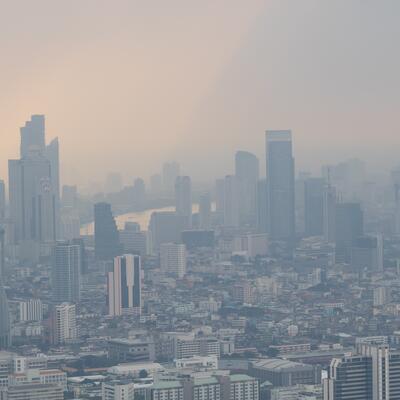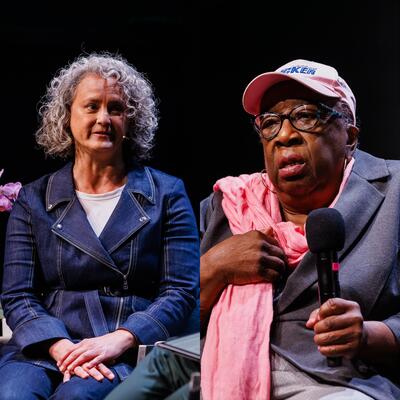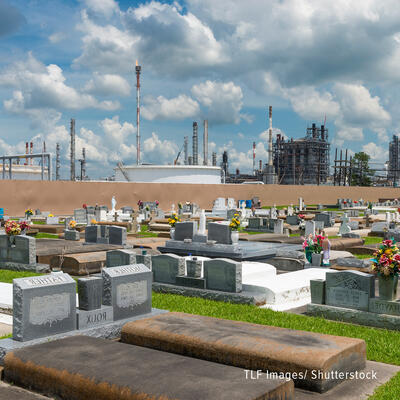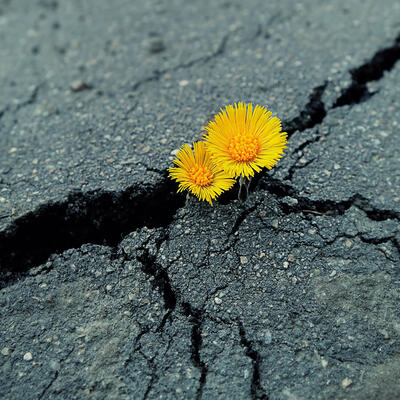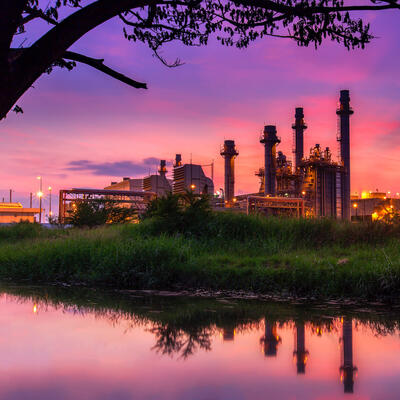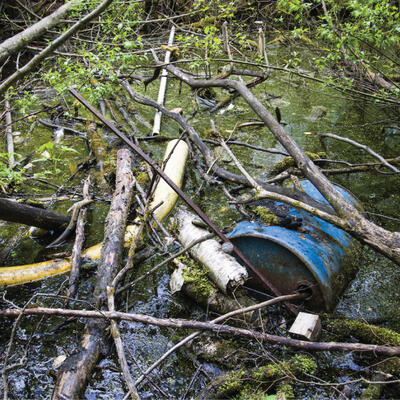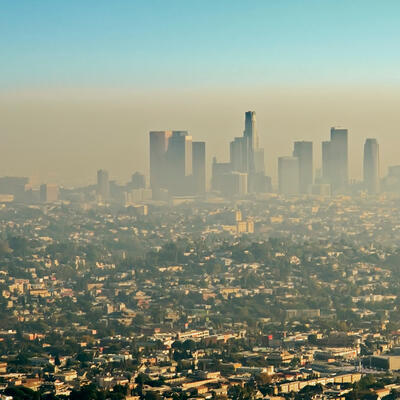
What’s in My Air?
Guests
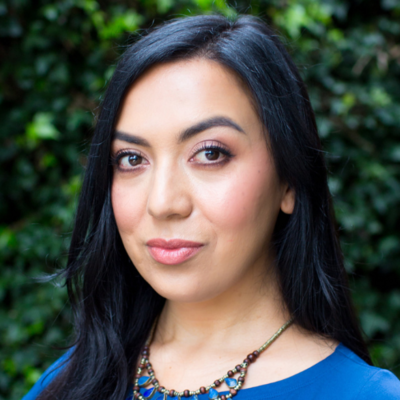
Davida Herzl
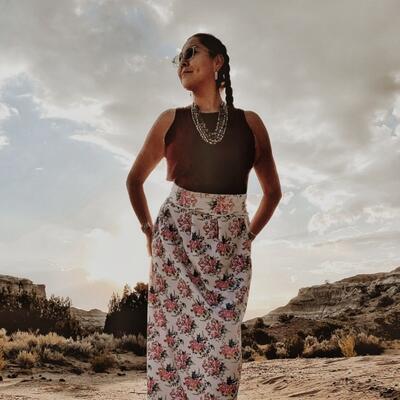
Kendra Pinto
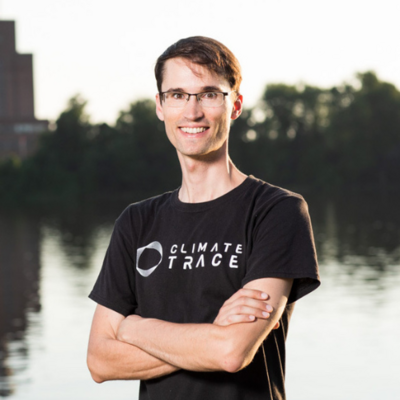
Gavin McCormick
Summary
Key to addressing the climate crisis is having an accurate picture of greenhouse gas emissions. Over a 20-year period, methane is 80 times more potent a greenhouse gas than carbon dioxide. Yet those responsible for releasing methane into the atmosphere often don’t even know how they themselves are emitting. And methane is only one of many harmful air pollutants that result from our dependence on burning fossil fuels.
Now, research coalitions, citizen scientists and activists are using a slate of new tools to detect and report emissions. They’re also using many of the same tools to shine a light on exactly how and where other deadly fossil fuel pollutants, like nitrogen dioxide and particulate matter, are affecting community health.
Davida Herzl is co-founder and CEO of Aclima, a company tracking climate change pollution at the local level to address what she sees as two big gaps in our understanding.
“Although we are facing a global climate crisis right now, we actually don't have the measurement infrastructure to really know where those emissions are coming from. And two, we don't really understand who’s being impacted by those emissions down to the block level, down to that really hyper-local resolution,” she says. The data collected by her group has been used by the West Oakland Environmental Indicators Project to build a clean-air action plan to reduce emissions across the community. Herzl says the plan had almost 100 different interventions based on Aclima’s hyper-local data. “Everything from investing in reducing bus idling and truck idling to really using the data to identify major opportunities for retrofits at the port.”
On the other side of the spectrum, the research collaborative Climate TRACE is publishing data on global emissions gathered through a combination of satellites and artificial intelligence. Project co-founder Gavin McCormick says the data has actually been encouraging when it comes to verifying countries’ emissions reduction pledges made under the Paris Agreement. The data can also provide clear guidance as to what to target next.
“We can see who the biggest emitters are. We can see their ownership in a lot of cases, but most intriguingly to me, we can see who is producing cleaner and less clean,” McCormick says.
Air quality data also makes plain the inequities faced by front-line communities who have long suffered the effects of harmful air. Environmental groups like Earthworks have been collecting data in oil and gas fields using specialized cameras that record visual evidence of emissions. Kendra Pinto is an Indigenous Field Advocate with the group, and member of the Navajo Nation. She prioritizes collecting oil and gas emissions data in residential Indigenous communities, which she feels are underserved by state and federal regulatory agencies.
“How often are we listening to folks who are dealing with direct impacts of extraction?” she says. “Even if we stop permitting new leases, that's not gonna stop the toxic pollutants from the existing infrastructure that's already there,” including abandoned and orphan wells. And a lack of sufficient regulators means many problems go unaddressed.
“We can talk about rules and regulations for the industry all we want but the cold, hard truth is these rules and regulations don't mean squat if they're not enforced by the appropriate agency,” Pinto says.
Aclima’s Herzl hopes that increasing the amount of reliable, real-time, accurate air-quality data will make a difference.
“We’re mapping this image of pollution that has been invisible up until now,” Herzl says. “Now policymakers and city governments and state governments and companies can really target their dollars on reducing those sources of emissions.”
Related Links:
Earthworks
Aclima
Climate TRACE Emissions Map
How EPA's draft methane rule targets 'super-emitters'
Secretary Haaland Announces Steps to Establish Protections for Culturally Significant Chaco Canyon Landscape
Full Transcript
Note: Transcripts are generated using a combination of automated software and human transcribers, and may contain errors. Please check the actual audio before quoting it.
Greg Dalton: This is Climate One. I’m Greg Dalton.
Over a 20-year period, methane is 80 times more harmful than carbon dioxide to the atmosphere that makes life possible on earth. Yet many companies responsible for releasing methane into the sky often don’t know how much is really being emitted. And methane is only one of a suite of harmful air pollutants that result from our dependence on burning fossil fuels.
Now, research coalitions, citizen scientists and activists are using a slate of new tools to detect and report emissions. They’re also working to shine a light on how communities are affected by other deadly fossil fuel pollutants, like nitrogen dioxide and particulate matter. Such data will be an increasingly critical part of local regulation and hopefully bolster the accountability of international agreements to cut emissions.
People in the fire-prone west may be familiar with Purple Air, which provides hyper local particulate data and became popular during the mega wildfires. Davida Herzl is co-founder and CEO of Aclima, a company working on a new approach to diagnosing the health of our air and tracking climate change pollution at the local level.
Davida Herzl: I actually founded Aclima over a decade ago because it was clear that there was a big gap in our understanding of two really critical features of air pollution and greenhouse gasses. One is that although we are facing a global climate crisis right now, we actually don't have the measurement infrastructure to really know where those emissions are coming from. And two, we don't really understand who’s being impacted by those emissions down to the block level down to that really hyper local resolution. And there's been a big push and I think a demand I think a lot of the citizen sensor consumer sensor devices and adoption, what that represents is demand for local knowledge when you're trying to protect your family and yourself from these big sorts of events, right. What we're really trying to do is to create the measurement and data infrastructure to not just respond to the short-term events but to really understand over long periods of time and on an ongoing basis really quantifying all pollution everywhere. We literally measure everything. So, we measure PM and all the criteria pollutants. So, basically all of the pollutants that are regulated by the United States EPA. We also measure all greenhouse gasses. So, we measure things like methane, an extremely powerful short-term greenhouse gas that short-lived has very significant warming effect. And we’re not doing enough to manage methane emissions. And then we also measure toxics. So, all of the pollutants that are associated with petrochemical production and heavy industry. So, benzene, toluene, ethylene, all the enes. And they tend to be associated with things like cancer and really significant and acute health impacts. We measure all of this with a proprietary and specialized sensing technology that we've developed over many years that gets deployed on fleets of vehicles. And as those vehicles are driving through city streets we’re mapping this image of pollution that has been invisible up until now. And so, we're really focused on finding those sources of emissions and where they intersect with people. So, that now policymakers and city governments and state governments and companies can really target their dollars on reducing those sources of emissions.
Greg Dalton: So, what happens with your data and what ways do you make it accessible for people?
Davida Herzl: So, under the United States Clean Air Act there are specific requirements for how you measure air quality. But the technology that's been used for those kinds of measurements is very expensive, very difficult to deploy. And you only see, they only measure a few pollutants. And so, where we really invested significantly was in the science to enable really high-quality data that could be used to target sometimes billions of dollars into big emissions reductions project. So, to give you an example of how our data gets used, one of our long-standing partners is the West Oakland Environmental Indicators Project, which is led by an incredible group of cofounders that have really been building out incredible capacity in using data to drive local policy solutions. And so, here in California they were the first community to actually have block by block data that we developed and generated with them. And using that block level data and other kinds of data that they integrated into their analysis, they worked with the local regulators to develop a transformational plan to reduce emissions across the community that had almost 100 different interventions based on that hyper local data. Everything from investing in reducing bus idling and truck idling to really using the data to identify major opportunities for retrofits at the port. And so, that has been really a model for how you can use data to shape climate action plans that improve the community that reduce air pollution and also make those communities that are able to not only address climate change but actually use it as an opportunity to create jobs and bring in more economic development. And of those hundred interventions a third are in active implementation.
Greg Dalton: And for people who aren't familiar with West Oakland, it's a neighborhood sandwich between a band of freeways and one of the largest ports on the West Coast. High concentrations of local air pollution. That’s a powerful image, the idea that you know an idling bus so we could actually visualize capture and present how much pollution is being generated by an idling bus or another source of pollution. It's well-established that low income communities often near freeways like West Oakland and Long Beach and elsewhere, and other sources of pollution have dirty air. So, in one sense, you know, it sounds like your data is kind of providing more proof of what we already know that low income communities of color have terrible air.
Davida Herzl: We do know that and that's largely because of historical redlining practices, right, where in the United States because of land-use practices that were fundamentally racist communities of color got relegated to very extreme proximity to major sources of emissions whether it's freeways or whether it's ports or factories or energy production from fossil fuels. And so, in West Oakland, for example, a lot of people aren't aware that the 580 and the 880 are segregated. That the part of the freeway that's going through, you know, the community of color. That's where all the diesel trucks are allowed to go. The freeway that is going through white more affluent communities, diesel trucks are actually not allowed. It's illegal to drive through that freeway corridor. And so, what ends up happening is you get this disproportionate burden. Now communities have been speaking to this issue forever. I mean you can look at the health outcomes, whether it’s asthma or, you know, other kinds of disease that is associated with pollution. I think what our data is doing is really giving those issues color; they’re quantifiable, you know, we can now hold and create a framework for accountability that can say if I'm going to invest you know as if investment is gonna come into my community I wanna make sure that it's going to the highest impact use. And that block by block measurement is critical because one of the things that we've discovered through our work with West Oakland and now a lot of follow-on scientific work that we've done, including with the US EPA, is that pollution is truly hyper local. It varies by 800% from one block to the next. But because pollution is so hyper local you can't actually understand those specific sources and specific impacts unless you have the data to then see am I having an impact, right. I mean we can see, for example, not just idling trucks, but we can see precisely where all the natural gas leaks precisely where is methane emitting from, you know, a facility where the community has been plagued with odor issues. And we can actually go and measure that and say okay this is an area that needs investment. And so, that is critical to actually shape investments which at the end of the day is what we need to do to really restore an equitable situation where we all have access to clean air.
Greg Dalton: Well, it’s clear that you're filling a data gap. The federal government hasn't made the investment in these technologies but it’s probably not a real for-profit business case for companies to develop this technology on their own to generate a revenue stream. So, how are you funded and are you a public benefit corporation, nonprofit, you know, who saw the need to kind of put the money into this gap between private market and what the federal government has invested in?
Davida Herzl: Yeah. So, we are a private sector company. And we are for profit, but we are a public benefit. In that we’re not singularly for profit. as a corporation we take our obligation to society and our stakeholders very seriously, but actually we think that in the same way that you have to measure what you manage if you're a business and look at the bottom line and make sure that you know you are managing costs and revenues and ins and flows, ins and outs. That when it comes to climate change that’s the fundamental problem, Greg, that we haven't integrated these costs into our decision-making across the board. And so, we had a different idea we said actually in order to start incorporating these issues and impact on society and to how we measure performance across the board we need data that measures and tells us what are those emissions. We talk about global CO2 levels. We talk about global methane levels. Well, there’s just a few stations that are taking those measurements. But when it comes to actually changing the game and changing the state of affairs of climate change, we need to think about climate data and emissions measurement as importantly and as significantly as we think about financial performance and financial data. Because it's not just about financial performances actually, are we actually collectively as an economy, ensuring a livable planet? The answer today right now is no. And so, how do we really create shared accountability here to improve conditions for everybody. And my argument is that that a breathable layer of air is actually foundational to a functional economy,
Greg Dalton: Yeah, human right, perhaps even yeah, there’s a whole economy burgeoning around carbon accounting and measuring, etc. So, I’m thinking about your cars driving around and detecting all sorts of pollution and levels that hasn’t been detected before by the more centralized EPA collection models. And that could be pretty uncomfortable for factories, refineries, industrial sources of pollution who suddenly feel visible and think that you might be able to help them by saying hey, you’re leaking methane. But what's been the real reaction by going to sources and say, hey, did you know you’re leaking this much?
Davida Herzl: I understand why you would why people would have that perception, right, that industry would be pushing back. And that was frankly one of my biggest concerns as we were scaling up our data collection. Concerns that you know we would have a lot of pushback because we are providing unprecedented transparency and we’re doing it at a level of scientific accuracy that hasn't been done before. So, we have a cooperative research and development agreement with the United States EPA. In order for us to be adopted by these regulatory customers at the state level at the local level, you have to pass a very high bar of scientific rigor. What’s happened though, and I think you're, you know, we’re all seeing this is that there is a ton of pressure either from a regulatory perspective or from shareholders or from just basic license to operate. That we are no longer in a reality where it's just okay to emit these pollutants and to do it in a way that is harming people or harming communities but also in many instances is actually undermining performance. If I’m a gas company and I'm emitting methane, which today, look at the current global energy market, every single iota of gas that I'm losing that’s wasted product that is really hard to replace right now because of all of those supply chain issues. And so, I think there's been a real shift in the marketplace and in the private sector and frankly, the private sector is quickly becoming one of our larger customers because they are being really held accountable to improving emissions, reducing emissions and our community partners are playing a big role in that.
Greg Dalton: Has there been an enforcement action based on your data has any air quality board gone into a particular industrial facility and said, look, we got this data you need to clean up your act.
Davida Herzl: We’re letting the regulators tell those stories and they will be ready to tell those stories soon. But what I'll say about our data is that imagine that you could put on x-ray glasses right, look out your window and suddenly be able to understand where all of these emissions are coming from. Well, when you have those x-ray glasses on that tells me if I'm a regulator where to go and look, right. And before our customers were doing this work in the blind based on complaints and they had very limited resources. I mean if you look at the scale of emissions and pollution, there's just there's a lot to do to catch up right, with the scale of the problem. And so, if we can more efficiently tell them where to go look or if I'm a gas company where to go fix the leak. you can respond much more quickly, you can reduce those total emissions and take action to actually fix the issue. And it's not always enforcement, right. We also, our data also directs investment. I’ll go back to the example of West Oakland where our data helped target incentives to improve equipment that was emitting pollution and that needed modernization in order to really reduce total emissions. And sometimes I have to say we find really crazy things that you would not expect the size of some of the leaks that we see, for example, is kind of staggering.
Greg Dalton: This is Climate One. I’m Greg Dalton. Let’s get back to my conversation with Davida Herzl, co-founder and CEO of Aclima, which is mapping hyper local air quality. Recently an EPA advisory board criticized the agency for not using satellite air data to track local emissions. I asked Herzl how much of Aclima’s data is available–and thus actionable–to regulators and the general public.
Davida Herzl: So, it took years for us to figure this out because the regulators want to make sure that as they're taking action with the data that they really understand the rigor behind it. And so, there is a long process for us in going through that evaluation and rigor. But we’re now making that information in the maps publicly available and we’ll be doing a lot more. working to make that data really accessible and usable for the nonscientific kind of members of the public. And that’s gonna be very important information for really gauging you know potential long-term impacts of being exposed to those pollution hotspots and really understanding those persistent levels of pollution over time.
Greg Dalton: Elsewhere in this episode we talk with Gavin McCormick of Climate TRACE which is mapping carbon emissions of methane on a global scale. How do you see your two approaches working together to bring emissions in check? One is very hyper local and his is, kind of global macro.
Davida Herzl: The way we see it is that all of these different approaches to measuring and understanding emissions are critical. We need all resolutions of data we need all resolutions of understanding. We’re really filling a critical gap because in the absence of measurement at the local level what's been done is the development of these tables where you sort of you know map the kind of emission with emission source with the typical sort of emissions that may come off of that. They literally go and test an engine to see how much a specific engine may emit. And then they develop these factors that you apply to entire sectors of the economy. But those models have not been ground truthed with hyper local measurement. And so, we see our role as a source of ground truth to really improve our understanding of those emissions at scale and ultimately improve the models and how we can actually you know forecast much more accurately the work that he's doing is incredible. He's providing a global view and doing it at a more sectoral level and also looking at the largest emitters. Where really Aclima where we differ is that we’re just very, very focused on that human intersection like where are the sources relative to where people are experiencing those sources. And it's just a different view of a massive problem that needs to be better quantified across the board.
Greg Dalton: As we make this energy transition from fossil fuels to renewables it’s about one source of power, electrical power. It's also about other forms of power. Human power political power. How does your data shift power?
Davida Herzl: Fundamentally, I think you know one of the major motivators for doing what we do we truly believe that you know air, the climate we live and breathe in is the fundamental ingredient, one of the fundamental ingredients for life. It's the one thing that we all have in common. Every few seconds we all take in a breath of the same air. And we should have much more agency in that and much more power to influence the direction of our long-term health of our environment that we depend on. Transparency changes that formula; transparency changes that equation, the equation of power to actually be able to create a much more informed public to give companies that want to do the right thing the information needed to step up and actually do what they need to do for regulators to write the rules for policymakers to write the rules that ensure that we all get to experience that right to clean air. And so, I think fundamentally that is the role of transparency. That is what we’re here to do is to ultimately translate all of this data into a more just and cleaner and fairer world.
Greg Dalton: Davida Herzl is CEO and Cofounder of Aclima. Davida, thanks for sharing your story of transparency and empowerment and innovation. I really appreciate it.
Davida Herzl: Yeah, absolutely. Thank you so much, Greg.
Greg Dalton: Whereas Aclima uses cars and computers to gather emissions data in urban environments, others are out on the ground in rural areas tracking similar air pollutants. Kendra Pinto is a Diné activist in New Mexico. In her role as Indigenous Community Field Advocate with Earthworks, she collects air quality data and advocates for clean air and water in the Greater Chaco Canyon region. She spoke with Climate One’s Ariana Brocious.
Ariana Brocious: The Four Corners Region contains significant oil and gas development on federal and tribal lands. So give us a sense of what it feels like as a resident of the Navajo Nation in Western New Mexico.
Kendra Pinto: Growing up in this area, it wasn't anything that I really paid attention to. Like I knew some of my family was working in the gas fields, but it wasn't something that I considered dangerous or toxic. It wasn't until my sort of early adulthood when I considered how dangerous all of this can be. This land has mostly been untouched around my home. But within the past 10 years, it has completely changed. And so there's a lot of, not just physical, but there's mental aspects that are included among this struggle within the checkerboard area that I'm in. Back in July 2016 we actually did have an explosion happen about five miles west of where I live. And so, you know, at the time it was sort of a, well, maybe or what if, but now we say, when will it happen again? Because these well sites are multiplying everywhere around me.
Ariana Brocious: Gosh, that has to be scary to have an explosion happen so close to you. Did anybody get hurt?
Kendra Pinto: There was a brief investigation on that explosion. I never got a full report. I mean, I didn't live in the immediate zone, but there were 55 residents that were evacuated within that area, and the fire burned for five days because that was deemed the safest route possible. That's horrendous. Just imagine all of those toxins that were off gassing and burning and the people in this area were breathing it for almost a week. And there was nothing we could do about it.
Ariana Brocious: Yeah. That does really paint a picture of what it is like to live in such an active oil and gas region. So your work as a thermographer with Earthworks involves using this specialized camera that helps you visualize emissions. Can you give us a sense of what a typical field day is like when you go out with your camera equipment?
Kendra Pinto: So this camera has a special filter inside that basically makes invisible visible. But the gasses that we are looking at are hydrocarbons. And so one of the main gasses that we focus on at Earthworks is methane. We can spot it with the camera because the camera's based on how the hydrocarbons absorb infrared energy. And so it creates this visual picture. And whenever I go out into the oil and gas sites, I focus on oil and gas wells that are located, in and near residential areas. I'm able to go up to the outer edges of the oil and gas sites and sort of scan the site with the camera. If I do find emissions that are sort of pouring or venting out of either like the thief hatch or flare sticks on compressors, I will record a short video and send these videos to the New Mexico Environmental Department under an environmental complaint form. And so this basically gives the agency and the operators direct evidence that this is happening. Like emissions are not constantly. Some of them are intermittent, but emissions are happening out in this area.
Ariana Brocious: Once you've submitted it to the New Mexico Environmental Department, what happens then to the data on their side of things after you've shared these videos?
Kendra Pinto: Well, Earthworks, we keep a running log. So we're better oriented. But also, this is technically sort of a paper trail, you know, it's creating this log of emissions that are happening that aren't found by inspectors. And when we get these complaints, they definitely serve as a tool for the community here. One of the biggest challenges with living with oil and gas in my area at least, is that when they do happen, if someone happens to be out hiking or riding the horses and they smell like a rotten egg odor in the air, who do they tell? Who do they report it to? And that's what I'm here for, is I want to be able to tell people, well, you know, if we smell something suspicious in the air or you see some kind of liquid that's black or brown running off a tank, you get a hold of so and so. There's not a lot of educational tools that are available for locals to report those kind of events that are happening around them, even though they're dealing with them.
Ariana Brocious: If the state agency wants to sort of verify the findings that you and others are reporting, have they done that? Do they take your imagery and then go and check up on those sites and let you know if in fact it's a problem that needs solving, what happens?
Kendra Pinto: The agency that I filed these complaints with rarely contacts me afterwards. I've only ever had one successful complaint followed through with and that was back in July of 2019. I reported an unlit flare stack as a community member, not as an Earthworks staffer. And I think that might have made a slight difference, but I wouldn't say that could happen every time. When I did report this event, it was about a mile near my area and I actually did get a call back, but it wasn't from the agency that I reported to. It was actually a phone call from the oil conservation division. And the OCD staff was on site to check out the complaint that I submitted.
Ariana Brocious: So I understand that a lot of the communities you prioritize are rural. And also indigenous and that's a big focus of your work residential communities that are amidst these oil and gas fields. Why is that important?
Kendra Pinto: I think it's important because it's been missing for hundreds of years. I mean, how well are we listening? How often are we listening to folks who are dealing with direct impacts of extraction? A lot of the time when we talk about oil and gas or uranium or coal, a lot of the talk is about the industry or the companies itself that are sort of propelling the country to a number one stop in energy development around the world. But who are they stomping on in order to be number one in the world? It's the little folks, the little people that are dealing with toxic air and contaminated water. And it's super important that also, sort of these non-profit organizations or any organization should be listening to indigenous folks because we have been here for a millennia and we didn't destroy the land like we have been doing in the past couple hundred of years. So I want to be here to be able to help those who are willing to put up that kind of public fight.
Ariana Brocious: Yeah. And there's a proposal I'd like to just mention here. In November, 2021, interior secretary Deb Holland, announced that the Biden administration was thinking about a 20 year drilling moratorium on new federal oil and gas leasing within a roughly 10 mile radius around Chaco Canyon National Historical Park, which is in the area, part of the area where you are. But critics point out that that ban wouldn't do anything to stop the existing leases within that zone or just outside of it. And according to the BLM, about 90% of their lands within that area are already leased. So I'm curious what your opinion is on this proposal from Deb Holland if you think it would have any impact.
Kendra Pinto: Even if we stop permitting new leases, that's not gonna stop the toxic pollutants from the existing infrastructure that's already there. Well sites that are from the early nineties, there's sites that are even older than that, that are decrepit and rotting, and they have no operator managing it. So these are abandoned and orphan wells, and those type of things exist in my area. And I do think it has a lot to do because with my location and the fact that this is an indigenous community. And so creating a 10 mile buffer around the boundaries of the park is not enough. I will say that now it's not enough.
Ariana Brocious: And what solutions do you think there are then to make some changes short term?
Kendra Pinto: I think one way would be providing public resources for folks who are dealing with the impacts. I mean, in my area, I don't have a hospital. No fire station. No police station, which is kind of odd when you think about how much money, how much funding goes to the state from my area. Back in 2019, they made like over 20 million off the land that's near me. But what do I have in my area to show for it? Except pollution and metal barrels.
Ariana Brocious: So maybe diverting some of the money back into the community investing. More locally.
Kendra Pinto: So the communities have the ability to make their own decisions about what they wanna do with their home. That's not happening every day. And even with the public scoping that the Bureau of Land Management does with the Bureau of Indian Affairs, that's not enough and it's super late. I think they started having their joint public scoping meetings in like 2018 that was right around the corner. How long has oil and gas and other minerals been extracted from this country and from indigenous lands. But yeah, let's all remember that this is all stolen land. This is all indigenous land.
Ariana Brocious: Right. I guess I'm wondering if you think having these new tools can turn into action basically. If measuring the emissions is a method of getting more enforcement, more regulation and a way to sort of track and improve the air quality.
Kendra Pinto: We can talk about rules and regulations for the industry. All we want but the cold hard truth is these rules and regulations don't mean squat if they're not enforced by the appropriate agency.
Ariana Brocious: And why is that difficult in your region?
Kendra Pinto: Because of our ruralness. Some of us call this no man's land. Some of us call this the desert. Some of us call it the middle of nowhere. But the closest grocery store is about 50 miles away. We're nestled in the middle of the mesas. And because we're so spread out and also the Navajo Nation is so large. I think that leads to a lot of limited enforcement within my area. And also the fact that there's not enough funding for New Mexico Environmental Department to increase their amount of inspectors. And if they did that, if they increased the amount of inspectors, maybe they could get to the well sites that are in the rural area where I am. But I don't know, sometimes I feel like that’s setting the bar pretty high.
Ariana Brocious: Well as we wrap up here, Kendra, if you were to communicate one message, from the work that you've been doing in the last few years to people who don't live in a region that's so saturated with oil and gas production, what would that be?
Kendra Pinto: I think one of the messages is about folks who aren't familiar with the oil and gas within indigenous communities is that not everyone is benefiting with royalties. That's a huge misconception that happens. Like I don't receive any oil royalties, but I'm pretty sure folks out there think I do just because I live in this area. Or just because I'm Dine, I don't know. But I think the biggest message is there's no need for this outside help to come in and try to save us. These folks should be asking us what we would like and what we need done. That often does not happen within my area. We do ask for support. But the support needs to be flexible with indigenous ways of life.
Ariana Brocious: Kendra Pinto is Four Corners Indigenous community Field Advocate with Earthworks. Thank you Kendra, so much, for joining us on Climate One.
Kendra Pinto: Thank you for having me.
Greg Dalton: This is Climate One. I’m Greg Dalton. Mapping neighborhood-level emissions and regional air quality is one end of the spectrum. On the other end, more and more entities are working to gather emissions data on the global scale using satellites. Gavin McCormick is one of ten founding members of Climate TRACE, a coalition of tech companies, non governmental organizations, and universities working together to combine satellite imagery and artificial intelligence to make greenhouse gas emissions transparent. I spoke with him about their most recent dataset released during the COP 27 climate summit in Egypt.
Gavin McCormick: The big thing that we've done is we've been able to move from measuring the emissions of entire countries to the largest 72,000 sources of individual emissions on the planet. So I think one of the most interesting headlines here is we can see who the biggest emitters are, we can see their ownership in a lot of cases, but most intriguingly to me, we can see who is producing cleaner and less clean. So I'm intrigued by stories like which steel mills worldwide are producing cleaner steel than others, which ships produce less emissions per nautical mile. And we're hoping to accelerate, what it looks like to get better sort of climate intelligence about the best way to go green.
Greg Dalton: So if I hear you, you're not just about sort of shaming the dirty sources, but you wanna sort of celebrate the cleaner ones, the relatively cleaner ones.
Gavin McCormick: Yeah, I personally think, I mean, it's gonna grab all the headlines, like who is dirtiest, but I think if you talk about how are you really gonna fix climate change, naming and shaming is fine. But what really helps is figuring out, okay, what's a viable plan to do better? And one of the things that I'm blown away by, for example, is we are seeing oil fields that are 52 times cleaner per barrel of oil. There's a stunning capability here that allows us with better data to say, all right, what would you have to do differently to go greener, not just catch a few heavy polluters.
Greg Dalton: Interesting, cause I did note that 1% of facilities measured emit 14% of global emissions. These are some of these mega facilities often in Asia, Russia, et cetera, where they're just part of it was just massive scale. So that was part of my question was, some of the biggest emitters might be just cause they're really large, but you're measuring relative pollution output.
Gavin McCormick: Exactly, and so the first thing we wanted to do was kind of align around countries because we were there at COP. That's what the UN system is designed around. The second thing we wanted to do is to say, okay, let's get concrete about what we are actually talking about. I'm fascinated by stories like in Tunisia, 20% of the country's emissions come from a single facility. So I think it's really good to move to very concrete, what are we talking about when it would take to stop climate change. But as you say, I think the third and most interesting step is to say who's not bigger just because they are causing more economic activity. But who is more emissions per unit of something. That really lets us say, how could we do better?
Greg Dalton: And do these facilities know what you know as a, what's been the response to putting this data out there?
Gavin McCormick: Yeah, it's been interesting. So far we have had exactly one conversation with a company who disputed some of the emissions numbers. It turned out what was happening is that there were two very nearby facilities that we had thought were one facility. So they had a good point, but the emissions numbers were fundamentally right. So far the conversation with the emitters has been pretty straightforward actually. What I think is so fascinating is the conversation with buyers and governments. So not the folks causing the emissions, but the folks who have a lot of influence and sway about what would you do about them. So I'm intrigued with conversations with steel buyers, with cargo owners, with city officials, thinking about how they could clean up their cities, these kind of conversations.
Greg Dalton: And would you publicly name or call out? I mean, the data's available. You put it out there, but you don't sort of lift up or curate the data or name particular facilities, cause that's the, really what you're bringing here is this asset level, facility level data. Not like the Permian Basin, which we know is a big oil and gas field, of course it's gonna be a big emitter, but you're naming the actual locations in there. Will you publicly name them in the future?
Gavin McCormick: So they're all on the website for anyone to see. So anybody who's interested can go to climatetrace.org and see who do we think the biggest emitters in the world are and how that's evolving over time. But we have kind of a policy, we, we view ourselves as closer to Wikipedia. We don't wanna be in the business of editorializing too much and sort of picking favorites. So I probably actually won't in future be doing much naming names, although I'm sure there are organizations out there that are gonna do that with Climate TRACE data. We're a kind of just the facts situation.
Greg Dalton: How about at the country level? Your report cites Russia, Turkmenistan, US and Middle Eastern countries as areas of concern.
Gavin McCormick: The expectation we had going into this project is what we were gonna find is there were some countries that were wildly falsifying their emissions numbers to the UN. To my considerable surprise, that's kind of not what we found. And I think it's always interesting when you have a scientific finding that's not what the scientists are expecting. But the real thing we found is, although there are some areas for concern, the bigger story is not that there are certain countries falsifying. It's certain industries. So, I for example, would have told you before this project that I don't know, the coal industry and the oil and gas industry, they're both big fossil fuel industries that expect pretty similar behavior, but we've seen a really big spread. The coal companies, they emit a lot, but it's pretty much exactly what they've always said they emitted. But the oil and gas companies worldwide are the big outlier. We are seeing really significant discrepancies between the emissions we see from space of many oil fields, and what had been reported. And what's interesting is we’re seeing that in a lot of different countries, so I think if I'm gonna name anything, it's an entire sector.
Greg Dalton: So once again, oil and gas is the villain here. Is that because of the, perhaps coal facilities tend to be sort of one big, really large coal plant. But oil and gas can be many wells, many pipelines, more vast infrastructure. And is it possible that they just don't know what's leaking?
Gavin McCormick: It is very possible. So in the defense of the oil and gas industry, it's pretty hard to measure all of the emissions of entire massive pipelines. Something interesting on a technical level is that more of the emissions come from leaks in that industry. And so you can have the situation that a single leak, if it's happening at a really large pipeline, even in the middle of nowhere, very high pressure, can be responsible for an enormous share of your emissions. So I suspect that if they wanted to find these emissions, they could be doing a better job. But we are generally finding that a lot of the emissions in that sector, they come from accidents instead of intentional activity.
Greg Dalton: And in agriculture, I was rather surprised to see most of the top 100 emitters are rice fields, predominantly in Asia. And I'd been covering climate for a long time and didn't realize rice was such a dominant emitter in the agricultural sector. What surprised you in the data?
Gavin McCormick: I didn't realize that either. So this has been an education for me. I'm originally an electricity expert and in learning how emissions and other activities work, I didn't know that rice was so different than other crops. And I also didn't know in agriculture that so many of the emissions come from unnecessary fertilizer use. There's just sort of a common pattern of overdoing it. Which of course brings me hope because it's not like people are gonna stop eating rice. There's not a lot you can do about that, but totally unnecessary fertilization that we can spot from space and say, hey, you could do better, that's extremely actionable.
Greg Dalton: So how do you think these new findings should impact international climate action, bringing this new level of transparency?
Gavin McCormick: One of the most interesting things that we've been hearing is from a lot of environment ministers at the country level or the city equivalent, I guess it would be a sustainability manager at a city. That often they sort of had a vague sense that it was important to reduce emissions. But when you're trying to justify that to the treasury ministry in your country, the difference between, hey, we really have clear data on exactly what's going on, we have a plan for how to verify it. If it gets reduced, we can tell you in concrete terms exactly what facilities need to. The difference between that and ah, somebody should do something. It's like night and day. So I think the big potential here is to essentially line up what are the biggest sources of emissions. Not knock down all of them, cause some of those are really important for crucial economic activities. And it could be a long time, but sort of say, what are all the big sources that'd be pretty easy to do something about? And of all the conversations we've had, the two fastest moving I think are in the city space and in the corporate sector where we often find there is a big will to do something, but people don't have infinite resources. And if you can really say right for you in your city, these emitting assets are the priority for you in your city. It's a completely different to-do list. We are seeing a lot of interest in essentially getting more bang for the buck out of your dollars that you wanna invest in fighting climate change. So I think a lot of the story's about leverage.
Greg Dalton: And targeting resources and giving data to cities that may not have the capacity to do that. As of last fall, no country had submitted a complete accounting of its emissions to the UN climate change agency. It seems your work could force their hand and also check their math, which I guess you're saying is that their, their math, their self-reporting of numbers by countries to the UN seems to be accurate. So how is this gonna enhance that process?
Gavin McCormick: So I should sort of be precise and say we had an expectation going in that was going on was that countries were reporting information and it was not true. By and large, that is not what we have found. But what we have found is there's a lot of missing information. So there are plenty of countries that it's been 20 years since they reported anything. Now, that's one thing if like, oh, data is old. But think about that means that anything anyone has done in that country under the Paris Agreement, it's less than 20 years old. We have no record of that. And so, if a country doesn't have any information, I think there's a tremendous amount of value in providing independent information and that's sort of a different use case than we are expecting because although I think it's very valuable to ensure that everybody stays honest as a general rule, the problem we're seeing is like failure to report, not reporting untrue information.
Greg Dalton: It's nice to know that countries aren't fudging their homework. At last year's UN Climate Summit in Glasgow, more than a hundred countries signed the methane pledge promising to reduce methane emissions globally by 30% from 2020 level. Supporters of methane, also known as natural gas, say it burns cleaner than coal, but it can be worse than gas of small amounts leak as we've been talking about. So how does your work connect to the methane pledge?
Gavin McCormick: So one thing as we were just talking about how until now, countries have largely been honest with each other, and I think that that has tremendous potential for underlying the trust that is what makes negotiations work. But I think the pressure is gonna increase to falsify data. So if you think about a lot of these binding pledges, they're just now starting to have teeth, and the global methane pledge is a huge example of that. It's gonna start to be more tempting to kind of stray off that path. And so we think getting ahead of the system and making sure that there's honest, independent monitoring kind of from day one. So everybody making these pledges knows all along, like don't even bother trying to fake it because everybody's gonna see. I think now that the pledges are there and we are in this amazing place, the countries have all committed to doing the right thing. I think just sort of keeping everybody on that path is, is just fundamental to the climate fight at this point, particularly in methane where so often it is accidents and things that would be so easy to sweep onto the rug if no one's looking.
Greg Dalton: That's an interesting point that the stakes are gonna increase and there's gonna be more penalties, more incentives to cut corners or fudge numbers. Explain how the combination of satellites and artificial intelligence is allowing projects like climate TRACE to gather and synthesize data and how has that shifted your own understanding of emissions?
Gavin McCormick: So what brought me to this project is I was working on power plants in the United States and we had some technology that can reduce emissions automatically. But we can only do it because the US does such a good job of publicly and transparently monitoring its power plant emissions. Every hour, every power plant in the United States has a public reporting of its emissions. There's nothing like that in the world anywhere else. I had always assumed that in every sector, in every country, in the fight against climate change, everybody had access to good data and the more I've learned on this project, it's not the case in most places that you can monitor things on site. It's too expensive. And it's not the case that you can monitor easily from the sky because if you see a bunch of CO2 near a power plant, it's very common that it didn't come from that power plant. We forget that 90% of CO2 emissions still come from nature and there's wind and all of that stuff. And so it's actually very difficult by just looking at CO2 to be totally sure of where everything is coming from. So the big innovation here is you layer in machine learning. And what machine learning can do is it can, it can match up against all of the stuff we really know for sure, but it can bring in additional signals that give us further clues. My favorite example is a power plant when it's producing a bunch of steam, that is extremely, highly correlated with it's turned on and causing emissions. Okay, this year, how often was this power plant turned? When you see a factory farm, seeing the cattle from space, it doesn't tell you exactly how much methane they emitted, but it gives you a really good sense. And so what machine learning can do is bring in all of the other stuff we can see from space and the internet and true it up to what the CO2 emissions and methane emission sensors are seeing. So you get a way more detailed, accurate picture.
Greg Dalton: People involved in direct measurement say this type of modeling is not accurate and could be challenged by polluters. What's your response to that?
Gavin McCormick: I think the definition of accuracy in science is when you have an accurate measurement, you compare it and you see if they match. So, the way machine learning works is it's got a measurement of accuracy there. And so, it would be very unscientific to say because of the method you used, it is accurate or not. The right way to do it would be to look at the data and see how accurate is it in practice. And so I'll, I'll agree that some of our current, it's not like everything in Climate TRACE is perfect now, but I would really disagree with the idea that the method you use is the right way to measure accuracy in science. I think it's the match with the actual ground truth data that you can see. And that's why we're making all that public so that you can see for yourself where our algorithms are more and less accurate, and where there is more uncertainty.
Greg Dalton: California has a law that's requiring measuring, say factory farms, methane emissions from dairy and feed lots. So could a regulatory body use your data to actually look at a particular factory farm and use that for compliance purposes. Is that happening? Do you envision that happening where regulators could actually use this for compliance?
Gavin McCormick: Yeah, we're just starting to talk to regulators now, because we do take accuracy so seriously. I would say it's pretty early days for Climate TRACE. So I think it's useful now for any big picture rules. Like, there are some laws, that you cannot emit more than X and if we say you're 10 times more than X, like, okay, obviously it's happening, but I would be a little bit hesitant to use the current version of Climate TRACE for any, like really the details matter, legal enforcement situations, but AI is improving. Check back next year, and it might be different. We'll get there in the end.
Greg Dalton: Right. Or you might point regulators where to look, right?
Gavin McCormick: Mm-hmm.
Greg Dalton: Why is real time monitoring critical for this?
Gavin McCormick: So, my career began in electricity emissions and so a good example of why real time matters in electricity, if you have a power grid that is charging up an electric vehicle and at one time that power grid is mostly producing coal and at another time that power grid is mostly solar, the real world consequence of charging that vehicle, they're wildly different emissions numbers. And so by synchronizing electric vehicles, smart thermostats, batteries to when the power grid is cleaner, you can reduce a lot of emissions in a way that kind of doesn't cost anything. And so I think literally real time is only useful in those applications where you can pull a lever, and do something. But also consider that the state of the art in a lot of countries has been seven years, in some cases, 20 years since we had a look at all. So something not quite literally real time, but at least up to date, it's very useful for policy makers who wanna know if a law worked. So I had missed how often cities and states and countries they're experimenting with new strategies. And if you have to wait 20 years to find out how strategy worked, you will know so much less than if you're getting continuous real time feedback. And this is how corporations manage, you can't manage what you can't measure. And we're basically trying to bring that to emissions too.
Greg Dalton: So what kind of action do you hope will occur by shining a light on individual industrial facilities? Like you said earlier, it's kind of encouraging or celebrating the clean and efficient ones. What else do you hope will happen as a result of this new level of global transparency?
Gavin McCormick: So one use case we've seen a lot of is a policy maker who is trying to reduce emissions in their city or state who literally didn't know what the biggest source of emissions in their area was. So think about how you would prioritize, should you be investing in electric vehicles or in forestry if you don't even know which of those is the biggest deal in your region. So we think that just sort of saying, hey, here's where the emission is coming from, is one big part. Another big part we've seen is a lot of climate efforts fail. If you think about how many dollars have been spent on carbon offsets, and we often say like, ah, those didn't really work. Let's flip it in reverse. What if they did all work? And so I am really hopeful that we can support carbon markets and policies in saying, all right, we, we invested in reducing emissions. Did we see that yield? And can we hold people accountable for making sure that money is all actually achieving something? Be a lot of extra emissions reductions. And the last thing is just trust in the Paris Agreement. I know it's, it's not an amazing headline that we didn't see as much lying and cheating as people thought, but that actually is enormously good news for climate negotiators realizing they should be trusting each other more than they thought.
Greg Dalton: Yeah, that is encouraging that the self reporting is more accurate than you, than you expected. So how has working on this project affected your own personal hopes and fears and expectations for our shared climate future?
Gavin McCormick: You know, it's interesting. It's pretty stunning for an environmental activist to say that they're calming down. But I have just been stunned by how much good news I see in the data.
Greg Dalton: Can you say that again please?
Gavin McCormick: Yeah. I have been stunned by how well we are doing as a species. Nobody talks about this part. So one of my favorite analyses, for example, is I looked at how much are countries emissions increasing each year. And what I'm seeing in the Climate TRACE data is that the rate of increase is shrinking so fast we are getting real close to flatlining here. And I'm seeing that it's happening in every industry and every country. We aren't seeing a story that some people had believed that it's only the global north reducing emissions or something like this. And I'm seeing really a large number of cases where there's a concrete, simple action you could take that would reduce a lot of emissions without anybody having to lose their fortune or anything like that. And I'm becoming much more hopeful that we have underestimated how easy it is to make progress on climate change. I know that's not a common opinion, but I think people are gonna start seeing that in the data when they actually look at the real numbers.
Greg Dalton: I'm gonna replay that on a loop and when I need a little pick me up, I'm gonna replay those words along with David Wallace Wells saying the worst case scenarios are less likely that we are making progress. We need to acknowledge and celebrate that rather than get locked in this doom and gloom narrative that has prevailed in recent decades.
Gavin McCormick: And it's bad, but we're seeing more and more hope, frankly, than I'm used to. And I'm just adjusting to what I'm seeing in the data.
Greg Dalton: Great. Well it's credible for you to say that being data driven rather than kind of motivated, wishful thinking driven, it's a lot more credible. Gavin McCormick, founder and executive director of watt time and also founding member of Climate TRACE. Thank you so much for sharing your data and your authentic optimism today.
Gavin McCormick: Thanks so much for having me.
Greg Dalton: POD version: Climate One’s empowering conversations connect all aspects of the climate emergency. To hear more, subscribe wherever you get your pods. Talking about climate can be hard-- AND it’s critical to address the transitions we need to make in all parts of society. Please help us get people talking more about climate by giving us a rating or review. You can do it right now on your device. You can also help by sending a link to this episode to a friend. By sharing you can help people have their own deeper climate conversations.
Brad Marshland is our senior producer; Our managing director is Jenny Park. Our producers and audio editors are Ariana Brocious and Austin Colón. Megan Biscieglia is our production manager. Our team also includes consulting producer Sara-Katherine Coxon. Our theme music was composed by George Young (and arranged by Matt Willcox). Gloria Duffy is CEO of The Commonwealth Club of California, the nonprofit and nonpartisan forum where our program originates. I’m Greg Dalton.

